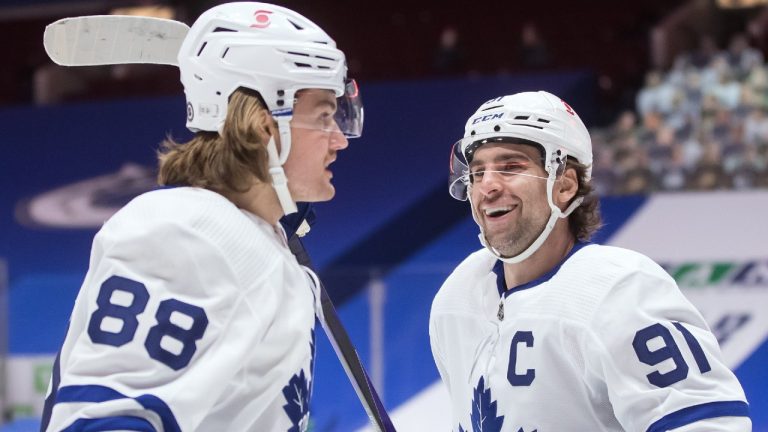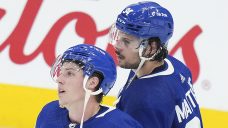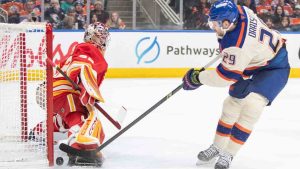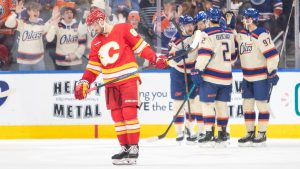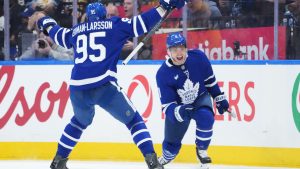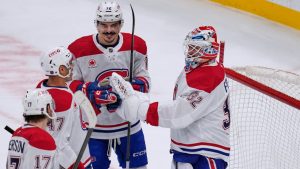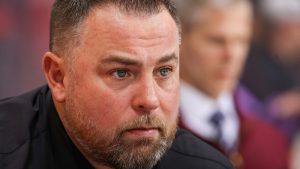TORONTO — Funny how expectations have changed, how windows have narrowed.
When these Toronto Maple Leafs were young and wild and free in 2017, they gave the back-to-back Presidents’ Trophy–winning Washington Capitals a fright in a thrilling, six-game, house-money playoff series.
Hope could only project upwards.
As all those young talents matured into their prime, as they committed to defending, surely they would develop into a powerhouse and regularly battle deep into spring.
Five spins around the sun later, this core is right back where it began, in terms of playoff results.
You won’t have to visit too many rinks around the city to find fans who have stopped dreaming of a Stanley Cup. Plenty of diehards have lowered the bar to “just win one round already.”
Inside the walls of Maple Leafs Sports & Entertainment, however, the bar remains 1967. And with every whiffed opportunity, time to quench the drought is running out.
Auston Matthews should have a Hart Trophy gleaming on a shelf in Arizona when camp opens for 2022-23. He’s under contract for two more playoff runs. That’s it. (Sure, he could re-up, but that is no certainty.)
So, when the Leafs run this sucker back, what will convince everyone — ownership, management, coaches, players, fans — that the result will be different in 2023?
Let’s consider the difficult decisions that lie ahead, starting from the top …
Will the brass change its philosophy?
Speaking mid-season, president Brendan Shanahan — now more than eight years into his reign — maintained that Larry Tanenbaum and the board was still behind his plan.
“Ownership has been fantastically supportive,” Shanahan said. “You keep pounding on that door until you finally break the door down.”
If a close playoff loss to a great opponent is enough to re-endorse Shanahan and GM Kyle Dubas, do these men tweak their approach at all?
Forget those old “build from the net out” and “defence wins championships” maxims.
Toronto’s unorthodox blueprint has been to horde a cluster of expensive, game-breaking forwards, double-down on a dynamic play-driving defenceman with wheels, then pinch pennies around the fringes.
Does Dubas simply demand more killer instinct again and go shopping for more David Kämpfs and Michael Buntings?
Or does he do something much more drastic?
That would be either trading prime William Nylander, who would fetch a king’s ransom on the market, or finding a creative and uncomfortable way of getting out from John Tavares’s no-move contract.
Such a blockbuster would be an admission that his original vision was misguided. It would also free up cherished cap space to dress a more balanced lineup.
Fact is, the stars — all healthy, all engaged, all producing — were not the Maple Leafs’ issue against Tampa.
Depth, defence, and one more save did them in.
Is Keefe the right man for the bench?
The Toronto Raptors fired Dwayne Casey after he’d turned in a Coach of the Year campaign. They won a title with his replacement, Nick Nurse, the very next season.
Sheldon Keefe is Dubas’ ride-or-die man. He led the organization to its best regular season in history. His points percentage in the regular season is .678.
There is zero evidence that he’s lost the room. The stars skate hard under his watch, and he has helped drive players like Pierre Engvall, Ilya Mikheyev, Justin Holl, William Nylander, Alexander Kerfoot and Timothy Liljegren into more complete players.
Keefe has also been out-coached in all three of his playoff series, despite having home-ice advantage and the better high-end talent in each one of them. His power play routinely wilts at the worst time, and he has been foiled thrice by teams more committed to protecting a lead.
Keefe is not a bad coach. Far from it. Neither was Casey.
Defensive guru Barry Trotz is a free agent. Just sayin’.
Let’s stop playing games in net, shall we?
Petr Mrazek was a whiff, and that one falls on Dubas.
The GM can attach another slice of the future and trade the remaining two years of Mrazek’s contract, or he could buy him out for a not-horrible cap hit: $1.03 million in 2022-23; $833,333 in 2023-24; and $1.43 million in 2024-25 and 2025-25.
At $750,000 Erik Källgren may be fine as a backup, and the price is certainly right.
The Jack Campbell question is a biggie.
His second-half performance should keep his asking price in check, but is this a championship-calibre goalie?
The UFA goalie market will be barren. Colorado’s Darcy Kuemper leads the pack, and the Leafs have expressed interest in the past. Ville Husso is young and intriguing, but the Blues have turned back to Jordan Binnington when it matters most. After that, you’re looking at re-signing Campbell, throwing a Hail Mary with an aging Marc-André Fleury, or poking around the trade market.
Anaheim’s John Gibson’s name pops up a lot, but his contract — $6.4 million cap hit through 2026-27 — is no joke, and his save percentage has sunk below league average for three years running.
The NHL is bereft of dependable goalies, and this is where the Leafs are getting punished for failing to draft and develop a solid one.
Which RFAs get their raises?
Both halves of the Leafs’ “fourth pair” in the post-season — Rasmus Sandin and Timothy Liljegren — need a pay bump coming out of their entry-level contracts.
Neither Swede has arbitration rights nor the stat line to take Dubas to the cleaners.
Bridge deals will keep their price reasonable, and more ice time in 2022-23, will be on deck.
Forwards Pierre Engvall and Ondrej Kase ($1.25 million each) do hold the hammer and should command more.
Our take: Keep Engvall despite his underwhelming playoff performance. Let Kase go. When healthy, his energy and versatility made an impact. But his injury history is too risky and left him a nonfactor when the games mattered.
Regarding the UFAs: Will Giordano hop on the Spezza program?
We’ll stand by our prediction that fan favourite Ilya Mikheyev has played himself out of town on a team that culls its middle class. The Cobra will go the way of Zach Hyman and Connor Brown and get his dollars elsewhere.
Provided their asking prices are reasonable, Dubas should try to retain serviceable role players Ilya Lyubushkin and Colin Blackwell. (Ending the parade of pure rentals also makes deadline trades look better in retrospect.)
The biggest question mark is Giordano, who will be 39 next time the puck drops.
The proven defenceman earned $6.75 million this season. He understands that he can be a top-four on a mediocre team or an awesome third-pairing asset on a contender. Surely if he’ll take a hometown discount, the Maple Leafs would love to have him.
If he wants to maximize his earnings, Dubas will be outbid.
Who gets traded?
We’ve saved the juiciest for last.
Again, this rests on our starting point about the organization’s philosophy. A blockbuster (read: Nylander) is one route if Dubas elects to go big-game hunting for, say, a Jakob Chychrun or John Klingberg or Colton Parayko.
The other is to pluck and prune around the fringes.
Alexander Kerfoot is both a Keefe favourite and a dressing-room favourite, but he had some rough moments in Tampa and will be entering a contract year. Is he a $3.5-million contributor? Yes. Is it worth exploring a trade before he’s due for a new deal? Also yes.
Some throw rocks at Justin Holl, but he’s been worth the $2 million he’s earning. Like Kerfoot, he’ll be entering the final year of his deal. Do you take the security, or move him out and bet on a less-expensive Liljegren taking another step?
If you clearly sense Mikheyev’s signing price will too high, can you be proactive and deal his rights for something in return?
The final candidate has us torn.
Jake Muzzin, 33, had a rocky year plagued by injuries. With all those hard miles, it’s difficult to see him resurging over the final two years of his deal.
And yet, he is integral to that dressing room and was fantastic in the playoffs. The Maple Leafs needed more Muzzin, not less, against Tampa.
No, the solutions to all these off-season questions are not easy. But Toronto put itself in this predicament, and time to solve the puzzle is running out.
